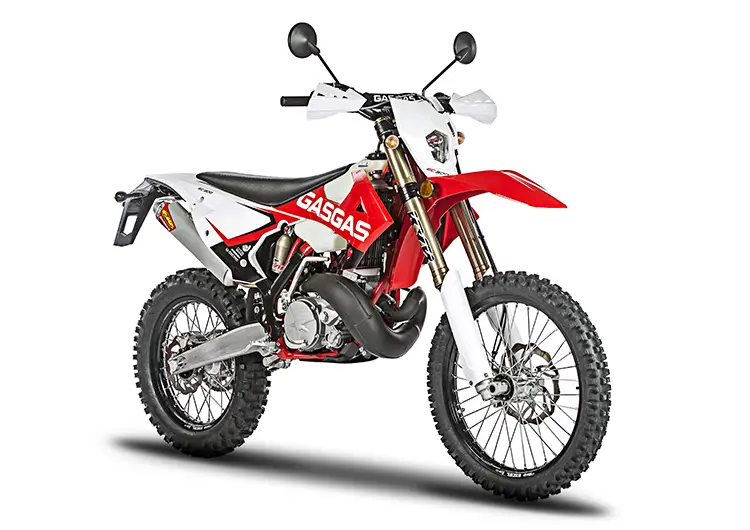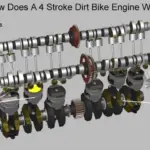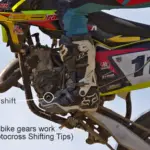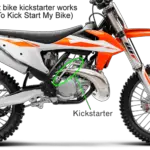
Have you ever wondered how a dirt bike engine works? Plus wondered what the differences are between 2 stroke vs 4 stroke engines?
Knowing a bit about how dirt bike engines work will benefit you as you progress and become a better dirt bike rider. This article looks in a bit more detail about dirt bike engines and the types of engine available.
How does a dirt bike engine work? How a dirt bike engine works depends on if it’s a two stroke cycle engine vs a four stroke cycle engine. One stroke in two produces power on a two stroke; whereas one stroke in four produces power in a four stroke. But the basic components of both engine types are similar, as they are both internal combustion engines.
They are similar in so far as they both have pistons, a cylinder block and head, fuel inlets and exhaust outlets (although these operate differently) and a crankshaft.
For both engine types, the lateral movement or up and down motion of the piston is converted into a rotary movement in the crankshaft in both engines.
How does the engine of a dirt bike work?
Most modern-day engines in a dirt bike work in a similar way to that of a car engine. Which is that most dirt bikes have a 4-stroke engine.
However, there are some dirt bikes that still have a 2-stroke engine as well, which is not very common in cars. Many years ago companies like Saab and Suzuki built cars with 2-stroke engines. But these are no longer built.

But in the dirt bike sport, two stroke bikes are still available from dirt bike manufacturers like KTM. You can also get a two stroke dirt bike from a smaller manufacturer like Gas Gas. For example the Gas Gas EC 250 pictured above.
In December 2017, KTM unveiled the world’s first 2 stroke fuel injected enduro dirt bike. Find out more about the 250cc and 300 cc KTM 2-strokes here.
The components of a basic dirt bike engine
The basic components of all dirt bike engines, regardless of whether they’re 2-stroke vs 4-stroke, are similar.
The basic components of an internal combustion engine include the following:
- Pistons – which form the basis of the combustion engine.
- A cylinder block and head – which is what houses the pistons.
- Fuel inlets or ports (See the differences between 2-stroke and 4-stroke engines below).
- Exhaust outlet or ports (See the differences between 2-stroke and 4-stroke engines below).
- Crankshaft – Connects to the piston shaft and drives the power via the clutch through to the gearbox and then to the rear wheel.
In all internal combustion engines, which is what a dirt bike engine is, the piston(s) move up and down inside the cylinder block. The piston’s movement is driven by the explosions of an air-fuel mixture that is ignited by a spark.
The spark is provided by a spark plug, which sits at the top of the engine. The spark plug(s) are screwed into the cylinder head, which is screwed down onto the engine cylinder block.
As the pistons move up and down, they turn the crankshaft. This lateral motion energy or the up and down movement of the piston is transformed into a rotary motion of the crankshaft.
It is this rotary motion that is transmitted along the crankshaft, via the clutch and transmission (or gearbox), through the sprockets and chain to the rear wheel of your dirt bike.
How the engines of dirt bikes are classified
Most dirt bikes tend to be classified by the size and stroke of the engine.
The size of an engine is classified by the capacity of the combustion chamber in CC’s. Where 1,000 cc is equal to one litre (0.22 gallon). The capacity of the cylinder is the maximum volume when the piston is in the most downward position in the cylinder block. This position is called the Bottom Dead Centre
So for example a dirt bike that has a 250cc engine, the 250cc is a quarter of one litre in cylinder capacity.
The second part of the engine classification is in terms of the number of engine strokes or cycles. Either a two stroke cycle engine or a four stroke cycle engine. So for example the engine may be described as a 350cc 4-stroke or a 250cc 2-stroke.
One final classification most dirt biker owners would also include, is the number of cylinders and the shape of these cylinders. Relating back to cars, this is the same process. Most have heard of the V8 engine. The eight represents the number of cylinders. whereas the ‘V’ means there are eight cylinders shaped in a V.
How does a 2 stroke dirt bike engine work?
Let’s take a look at the two stroke engine working principle. The 2-stroke engine is the simpler of the two types of dirt bike engine.
A 2-stroke dirt bike engine works on two strokes or cycles of a piston. On one of the two strokes, the air-fuel mix is drawn into the combustion chamber via the transfer port from the crankcase. As the piston nears the top of the combustion chamber the spark plug ignites the compressed air-fuel mix. This combustion creates high pressure, which forces the piston down on the second of the two strokes.
As the piston rose during the first stroke, this reduced the air pressure in the crankcase. This reduced pressure draws in more air and fuel mix, in preparation for the next cycle or stroke. This process starts over again to start the first of the two strokes once more.
You can read more about how a two stroke dirt bike engine works in this article: How does a two stroke dirt bike engine work.
How does a 4 stroke dirt bike work?
A 4 stroke dirt bike engine works on a principle of four strokes or four cycles of a piston.
There are two upward strokes and two downward strokes that make up the four strokes. These four strokes are called the intake stroke, the compression stroke, the combustion stroke and the exhaust stroke.
On the intake stroke, the intake or fuel valves are opened to let an air-fuel mix into the combustion chamber. On the compression stroke the piston rises up in the cylinder barrel and compresses the air-fuel mixture. During the next stroke, which is the combustion stroke, the spark plug ignites the compressed fuel. This combustion causes high pressure in the cylinder chamber and forces the piston down.
The final or fourth stroke or cycle is the exhaust stroke. During the exhaust stroke, the exhaust valves are opened to let out the burnt fuel or exhaust created from the combusted fuel. This burned fuel is forced out by the upward motion of the piston.
The cycle starts all over again to begin the first of the four strokes once more.
You can read more about how a four stroke dirt bike engine works in this article: How does a 4 stroke dirt bike engine work?
What are the advantages and disadvantages of a two stroke cycle engine
These are the advantages of a two stroke cycle engine:
What are the advantages of a 2-stroke dirt bike engine?
There are certain advantages of having a 2-stroke dirt bike, which include the following:
- Light weight – The engine of a 2-stroke weighs significantly less than a 4-stroke with similar power output.
- Simplicity in parts – There are between 30-50% fewer moving parts with a 2-stroke engine over a 4-stroke.
- Easier to work on and maintain – Due to a simplified engine setup, a 2-stroke is much easier to maintain and work on.
- Cheaper to buy – As there are less moving parts and the engine is less complex, they are cheaper to manufacture and to maintain.
- Easier to clear of water if it’s been swamped – As there are less moving parts to become affected by water, this makes it easier to clear out should you get stuck in water.
- Can work in any orientation – As there’s no oil reservoir in the crankcase because lubrication is achieved with the oil mixed in with the fuel, the engine will still work in any orientation. This includes when it’s upside-down.
- More power output – A two stroke engine provides more power than a four stroke of similar size and capacity.
What are the disadvantages of a 2-stroke dirt bike engine?
There are also disadvantages of the 2-stroke engine, which include the following:
- Increased fuel consumption – 2-strokes are less efficient, as some of the air-fuel mix is lost through the exhaust outlet on the upward piston stroke.
- Higher hydrocarbon emissions – Because the 2-stroke engine has the fuel intake and exhaust outlet open at the same time, this makes it less efficient. This is because some of the fuel air mix passes out through the exhaust outlet without ever being burnt.
- Total-loss lubrication system – The two stroke cycle engine works on the basis that the oil in the fuel is burnt. The oil needs to be mixed in with the fuel or constantly topped up if held in a separate oil reservoir.
The hydrocarbon emissions are reduced on the direct injection type 2 stroke engines, like the latest KTM’s on the market.
What are the advantages and disadvantages of a four stroke cycle engine
These are the advantages of the four stroke cycle engine:
What are the advantages of a 4-stroke dirt bike engine?
- More fuel efficient – As the four stroke engine works with valves that open and close, none of the air-fuel mix is lost from the exhaust port.
- More environmentally friendly – The four stroke engine does not work on a total loss lubrication system, so less oil is burnt in the combustion process. Also, as less of the unburned fuel is released with the exhaust fumes, the four stroke engine is therefore more environmentally friendly.
- Lubrication is cheaper and simpler – The four stroke engine is lubricated using a sump reservoir system. This means that there’s no need to constantly add oil to the fuel.
- More choice – As there are more four stroke dirt bikes available to buy, this makes them a better option for choice.
What are the disadvantages of a 4 stroke dirt bike engine?
There are also disadvantages of a four stroke cycle engine:
- Heavier engine – Due to having between 30-50% more moving parts, the four stroke engine is heavier than a two stroke of similar cylinder capacity.
- More expensive to manufacture and buy and service – As there are more moving parts to a four stroke, this means they are more expensive to make and maintain.
- More moving parts and therefore more complicated to work on – The servicing and maintenance of a four stroke is more complicated, as the engine is more complex.
- Oil changes can get messy – The engine lubrication relies on an oil reservoir. This oil requires changing every so many miles, which can be a messy process.
- Not as powerful – The four stroke engine is not as powerful as a two stroke engine of the same size and capacity.
How the 2-stroke engine is lubricated
Lubrication of a 2-stroke engine is different to that of a 4-stroke (see below for engine lubrication of a 4-stroke engine).
The 2-stroke engine gets its lubrication can be administered by one of two methods. This is either directly mixed in with the fuel as a pre-mix. Or alternatively from direct injection. Where the injection method is used, the two-stroke oil is held in a separate oil reservoir. This is then pumped into the intake track of the engine, where it’s mixed with the fuel on intake.
The pre-mix method is where the two-stroke oil is pre-mixed into the fuel before it’s poured into the fuel tank of the dirt bike.
The advantage of the pre-mix method is that it is as reliable as you are to mix it correctly. Which means, as long as you always mix-in the correct ratio of 2-stroke oil to fuel, the engine will always run correctly and smoothly, without the engine seizing through a lack of, or through no oil at all.
The advantage of the oil reservoir is convenience. By making sure the 2-stroke oil reservoir is topped up, the engine will always receive the correct amount of oil. The disadvantage of this type of system is that oil-injection pumps have been known to fail. When they fail, they do so without warning. The results are catastrophic for the engine.
This method of lubrication is known as a total-loss lubrication system. Which means that it’s required to always top the oil up.
How the lubrication of the four stroke cycle engine compares
The engine on a four stroke dirt bike is lubricated in a totally different way to the two stroke engine.
The crankcase of the engine is lubricated by a permanent reservoir of oil, which is held in the engine’s sump. Some engines work on a dry-sump basis. This oil is pumped around the engine to keep it lubricated and cool.
The oil in the crankcase requires changing every so many miles.
Differences between 2 stroke vs 4 stroke dirt bikes
There are a number of differences between 2 stroke vs 4 stroke dirt bike engines. Some of these differences have already been covered or explained so far. But here’s a list of the main differences between the two engine types.
- The 2 stroke engine has 2 cycles of the piston to complete a full combustion and exhaust cycle; whereas a 4 stroke has 4 cycles of the piston to complete a full combustion and exhaust cycle.
- One stroke in two produces power on a two stroke; whereas one stroke in four produces power in a four stroke.
- The crankcase in a 2 stroke is lubricated with the oil mixed in with the fuel using the total-loss lubrication system; whereas a 4 stroke has its crankcase lubricated using a constant oil reservoir.
- The combined opening time of the intake and exhaust ports in most 2-stroke engines can allow some amount of unburned fuel vapors to exit in the exhaust stream; whereas with 4 strokes the intake valve and exhaust valve system prevents this problem from occurring.
- The burned fuel in a 2 stroke contains more oil than a 4 stroke, as oil is mixed in with the fuel before combustion.
- The 2 stroke engine has between 30-50% less moving parts than a 4 stroke engine.
- A 2 stroke engine is lighter than a 4 stroke.
- The power output of a 2 stroke is up to two times that of an equivalent size 4 stroke.
How a 2-stroke engine differs from a 4-stroke engine animation video
In this video you will see the two types of engine compared
I hope you enjoyed this article about how dirt bike engines work
I’d love to hear from you. Tell us about your adventures of dirt biking in the comments below. Please also share your photos. Either from your cameras or videos from your Gopro’s!
If this article hasn’t answered all of your questions. If you have more questions about dirt biking (or specifically about how dirt bike engines work), please comment below with your questions.
There will also be many more articles about dirt biking for you to read and learn about this fabulous sport and hobby.
Have fun and be safe!




